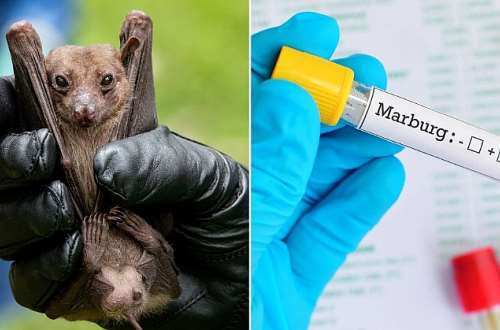
A professor of virology, Prof. Oyewale Tomori has alerted the Federal Government to take advantage of the arrival of the Marburg – an illness similar to Ebola – in Equatorial Guinea and possibly in Cameroon, to enhance surveillance in the country.
Tomori, who is also the former vice chancellor of the Redeemer’s University, Ede, on Friday in Abuja, emphasized the need for enhanced disease surveillance activities in the country, especially at the ports of entry between both countries.
Like Ebola, the Marburg virus originates in bats and spreads between people via close contact with the bodily fluids of infected people or surfaces like contaminated bed sheets.
Tomori told Science Nigeria that while Marburg disease is not as frequently reported as Ebola, both diseases can cause outbreaks with high death rates.
He said that African fruit bats are the reservoirs of the Marburg virus and can be transmitted to people from infected bats through their urine and/or excretions.
“There have been reports of infection of workers in mines inhabited by these bats or tourists visiting caves housing hundreds and thousands of these bats,” he explained.
He said, given the proximity of Equatorial Guinea to Nigeria (the distance from Malabo to Calabar is 144 km) and the porosity of the borders at probable ports of entry, it is urgent for the country to intensify disease surveillance activities and not take a break following the lull in COVID-19 activities.
“In addition to heightened surveillance, Nigeria needs to fine-tune her laboratory services to more effectively, accurately, and timely confirm the agents of the thousands of suspected hemorrhagic fevers we report annually.
“For example, in the past five years, our laboratory system has been able to provide a definitive diagnosis for about 10 per cent of all reported suspected Lassa fever hemorrhagic fever cases.
“One is left in confusion about the pathogens responsible for the remaining thousands of suspected hemorrhagic fever cases that are discarded undiagnosed annually,” he explained.
According to him, another reason for the intensification of surveillance is that serological studies have revealed evidence of past infections among Nigerian populations with Marburg or a Marburg-related virus (according to TOMORI, O. Fabiyi, A., Sorungbe, A. & Smith, A. (1988), Viral haemorrhagic fever antibodies in Nigeria populations. Am. J. Trop. Med. Hyg. 38(3): 407-410.
The professor of virology said that Marburg virus disease is a hemorrhagic fever that can affect the body’s organs and cause bleeding, noting that It is a highly infectious disease with a case fatality rate ranging from 23 per cent to 90 per cent.
“In the 2004 Angola outbreak, Marburg disease killed 227 (90%) of 252 people infected. In 2008, an American returning from travel in Uganda was retroactively diagnosed with the illness after recovery.
“In 2022, there were two Marburg deaths of the three reported cases in Ghana,” he said.
Tomori said that the Marburg virus is a zoonotic virus that along with the six species of Ebola virus, comprises the filovirus family.
“The rare virus was first identified in 1967 after it caused simultaneous outbreaks of disease in laboratories in Marburg, Germany and Belgrade (now Serbia).
“Thirty-one people who were exposed to the virus while working with tissues of infected monkeys became ill and seven died,” he explained.
According to him, the monkeys were imported from Uganda. Of the 16 Marburg outbreaks of varying magnitude reported between 1967 and 2023, eight episodes originated or were associated with Uganda.
“Other countries reporting Marburg outbreaks include Zimbabwe/ South Africa, Kenya, DR Congo, Guinea, and Ghana. There was a case of Marburg infection in a laboratory accident in Russia in 1990.
“Expatriate travellers visiting Uganda were responsible for Marburg importations into the USA and Netherlands in 2008,” he narrated.
Tomori disclosed that the incubation period for the disease ranged from two days to three weeks. “Symptoms begin abruptly, with an intense fever and headache. A few days after the onset, many patients experience vomiting, diarrhoea and stomach pain for up to a week.
“Severe cases are accompanied by bleeding within the first week. Some patients vomit blood or pass it in their stool. Patients have also bleeding from their gums, nose and genitalia.
“The disease can spread to the nervous system, causing patients to become confused, irritable and aggressive,” he said.
The expert said that most fatal cases last just over a week, noting that deaths were typically accompanied by severe blood loss and shock.
He explained that there was currently no cure or specific treatment for Marburg disease while adding that survival improved when patients are provided early with supportive care with rehydration and symptomatic treatment.
He disclosed that there was a range of drug and blood therapies to treat the disease under development.
Meanwhile, the World Health Organization (WHO) said earlier on Tuesday that it was increasing its epidemiological surveillance in Equatorial Guinea.
The country has, so far, reported nine deaths as well as 16 suspected cases of Marburg virus disease, with symptoms including fever, fatigue and blood-stained vomit and diarrhoea, according to the WHO.
Equatorial Guinea has also quarantined more than 200 people and restricted movement last week in its Kie-Ntem province, where the hemorrhagic fever was first detected.
There was an initial report that Cameroonian authorities detected two suspected cases of Marburg disease on Monday in Olamze, a commune on the border with Equatorial Guinea.
“On February 13, we had two suspected cases. These are two 16-year-old children, a boy and a girl, who have no previous travel history to the affected areas in Equatorial Guinea.
“Forty-two people who came into contact with the two children have been identified and contact tracing was ongoing,” Cameroonian authorities said.
Although the report has since been dismissed by the Cameroon authorities, the country continues to restrict movement along its porous border with Equatorial Guinea.

